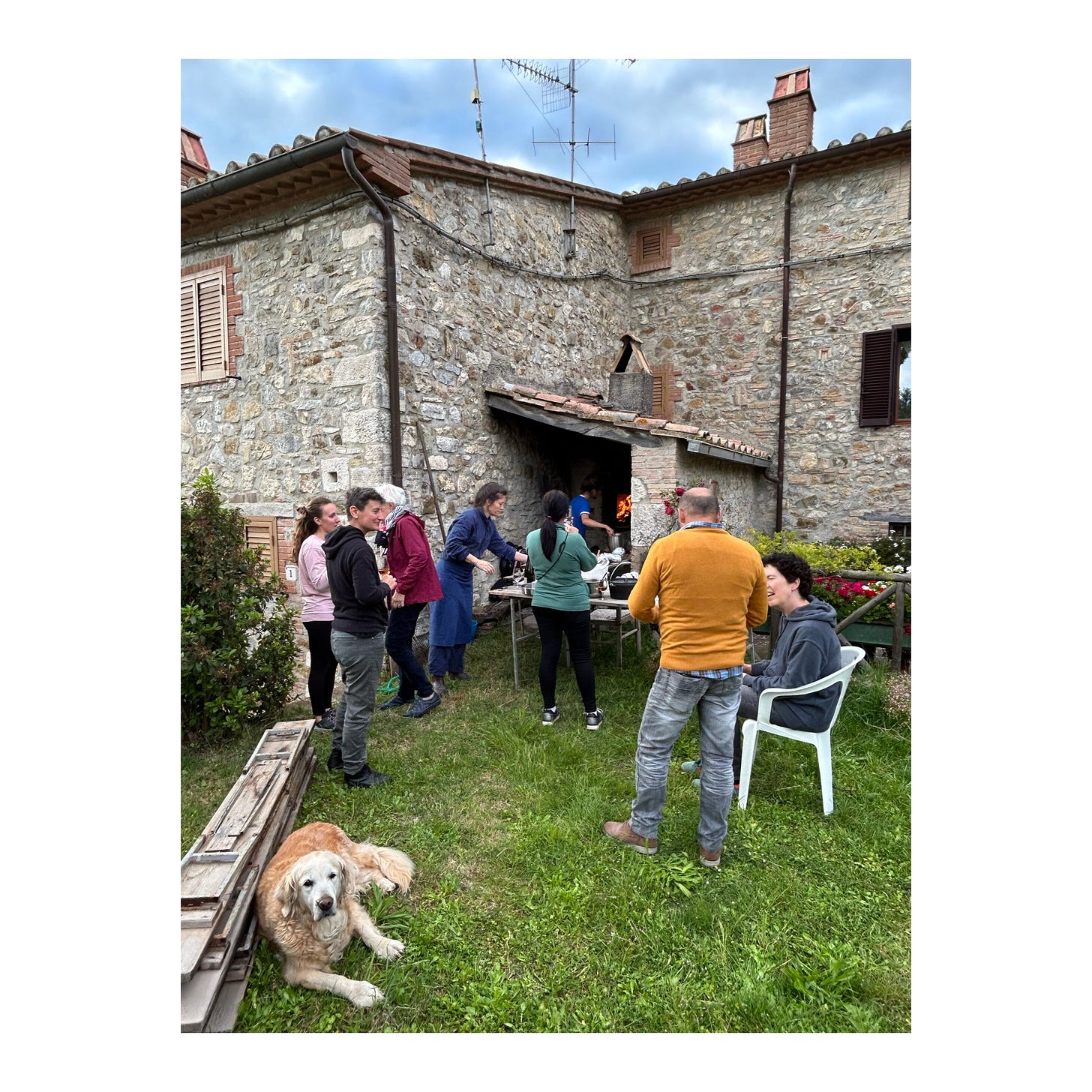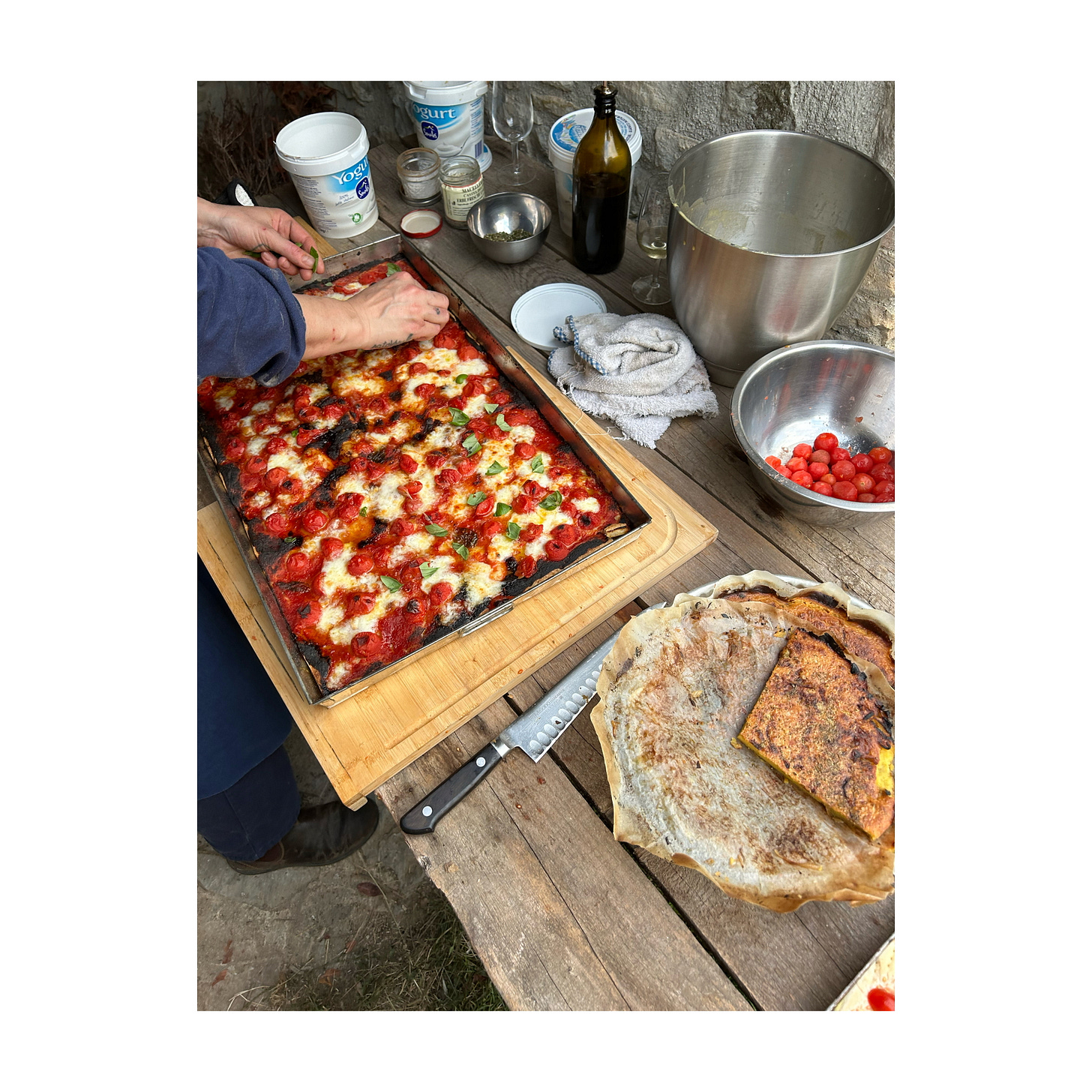The oven has a large chunk missing from the brick wall in the back. The large square bricks that line the floor are chipped and uneven. The tools, archaic: large wooden sticks with small paddles attached to the top for peels, and a different stick with various cloths wrapped around the end for a mop.
It’s been over three years since the brick oven’s last use, the townspeople of Rocchette di Fazio tell me as we gather to bake in it. Once active regularly, with many families in town taking turns in it to make their weekly bread, baked meats and vegetables, and pastries, it has gone largely dormant in the last few decades, a product of the population of this tiny Tuscan village dropping some eighty to ninety percent. The older generations passed away; the younger ones moved away, and the town’s institutions–the church, the school, the restaurant and bar–all faded into relics. These days, everyone in town has their own home oven, so there’s no practical use for it. It’s fired up every few years now, when one of the thirty remaining people in town gets a dash of inspiration.
It was Agata, the chef I’m working for here, who sparked the idea this time: bring together this dwindled, disparate community once again over a night around the oven. And so the owner of the tiny trattoria had gathered together a dozen of us to make dinner together in the oven. She asked me if I would want to help out, if I could show her how to light the fire, stoke the oven, move the fire to one side, and make food in the searing heat of the brick oven. She asked this with a small but detectable sense of guilt, knowing she might be asking a lot of me, tasking me with extra work on my day off.
I didn’t know how to tell her how much it would mean to me to assist.
Rocchette di Fazio is something off a postcard, with a small castle built on top of the hillside and sweeping views of the cliffs, canyon, and forests all around visible from its courtyard. But this region of Maremma is not your Under the Tuscan Sun Tuscany. There are not rolling hills of vineyards here, nor fancy villas basking in the heat, nor cypress trees standing tall on their border. That’s further north, or further south; the land here is wild. It’s cliffs and canyons and overgrown forests. It’s wild boar everywhere and deer and hare and hawks. It’s as many abandoned vineyards as functioning ones, and only a sparse amount of small towns nestled into the hilltops in between.
In many ways, the American mind in Europe gravitates toward history. Deep, deep history, the kind we can only fathom at, with its empires and kings and monuments and ruins. Those things are here in Maremma–an ancient Etruscan culture which was later wiped out by the Romans–but outside of a handful of Etruscan carvings and caves and some Roman churches, history can be hard to find here. Once in control of the land, the Romans chose to raze the region in a show of force, wiping away most traces of their former enemies. Nor was the land suitable for much civilization, as the wet and humid lowlands were teeming with Malaria and the poor soil was largely useless for vegetables. Those that did make it in Maremma instead turned to cattle, and later sheep, as settlers from Sardinia moved here and brought their livestock with them. This was the poorest area of one of Italy’s poorest regions, and the most iconic figures of Maremma were not winemakers or butchers or chefs but cowboys.
No, people do not flock here. They pass through because it’s on the way to Rome, or on the way to Florence or Siena, depending on which direction you’re heading. They stop because these sylvan lands are scenic for hiking and cycling, or because they’ve heard whispers about the restaurant I’m working at, Trattoria Cacciaconti. They buy land here because it is cheap and widely available, as long as you’re willing to put in some work clearing brush and erecting fences to keep the wild boars out.
There’s a lot of loss and emptiness in that. There’s also a lot of opportunity. A growing number of enterprising individuals, coming from all over Italy and beyond, are trying their hands at making wine, honey, and olive oil. Soil here may not be great for produce, but as many wine lovers will tell you, it’s often distressed soils that make the most interesting, nuanced wines. And soil here varies from one subregion to another, with volcanic soil called tufo producing some very fun, savory wines on the eastern edge of Maremma, and limestone and schist comprising the terroir of the western side.
A couple weeks ago, Agata brought together thirty biodynamic wine producers, most from Tuscany and a handful from Umbria and Lazio. It was not an event for the public, but rather for the winemakers themselves to sample each other’s wares and make connections, as over half of them were relative newcomers to the winemaking world. That’s the potential of Maremma: that its doors are open for the bold and creative soul who wants to tend to this land, a region that’s deeply ancient and brimming with youthful energy all at once.
My American mind, too, knows Europe as an ancient place. The last time I was here in Tuscany I was fifteen, accompanying my parents on a long trip to study communal brick ovens across Western Europe. My dad, a pastor at the time but a baker as well, wanted to learn more about this tradition, one that has largely faded across Europe but whose communal aspects might have some value in a country founded on individualism. Since returning, he and a team from his former church have built many in the Twin Cities which now function as community gathering spaces for pizza nights, fundraisers, workshops, and more. If you have ten minutes, his TED Talk about it shines a light on his work and inspiration.
But I was fifteen. I was cooking at that point, and intrigued by the ovens, but my interests were elsewhere. Two years later, however, I was learning the ins and outs of baking in brick ovens. My dad had built one in our backyard even before our trip to Europe, learning from a man named Alan Scott and his assistant, Dave Bauer, at a folk school in northern Minnesota. It became my summer job for a couple years, baking bread for suburban farmers’ markets. His idea, but my decision.
I struggled at first. I knew nothing of grain, of fermentation, of the heat arc in a brick oven. Ever the perfectionist, I hated that I was bad at something, and wondered why I hadn’t taken up work like my friends had in something simpler, like dishwashing or golf caddying. But that oven taught me a lot: how to build a fire, how to organize a schedule, how to wake up early and power through the pre-dawn hours. By my second year doing it I was experimenting with new breads, maintaining a sourdough starter, and figuring out just how much wood I needed to properly fire the oven, even if I was still messing it up half the time.
After college, at 24, I found myself the wildly fortunate inheritor of a legendary baking space in the mountains of Western North Carolina. My favorite bakers at that time were seasoned legends doing whole grain breads in rural spaces–Tara Jensen and Dave Bauer, who had each taken turns in the bakery before me, Dave Miller in California, Blaire Marvin of Elmore Mountain Bread–and here I was, taking over a famous space to try to do the same. Alan Scott had built those ovens too, and Dave Bauer had used them, and so I found my superstitious self connecting these threads from my childhood and wondering about concepts like fate and purpose and belonging.
I baked my way into burnout in two years. Sleepless nights tending to the brick ovens, a walk-in fridge that was never cold enough, a small AC window unit to try to compete with the North Carolina summer heat, mice. I loved it, I hated it, I lived for it, I dreaded it. And by my second year we were in the throes of a global pandemic and my primary source of income, workshops, were no longer viable. Something in me was shifting, too. I had energy and digestive issues my whole life, but they were approaching a nearly unbearable high. The day after a large bake, I could do little at all but lay in bed, bloated and moody and spent. In a mysterious phenomenon, the sourdough starters I was making all came out strange, taking too long to rise and then spilling over into sulfurous overfermentation all at once. Whatever fate and belonging I had speculated about before was now pushing me away. When the bakery was sold in 2021 to a new owner, I scurried away from Walnut, North Carolina in search of new horizons.
If there was any store in Rocchette di Fazio selling postcards, the image would be facing west, the sun setting over the sliver of Mediterranean Sea, painting the skies orange and casting dynamic shadows over the canyons and buildings. As the sun was in its final descent tonight, a group of us was pulling our dinner out of the oven. There were big, focaccia-like pizzas made by the neighbor, one with roasted tomatoes and the other with zucchini blossoms and gorgonzola. There was cecina, a chickpea flatbread. Agata had wrapped potatoes and red cabbage in fig leaves, and then foil, and tossed them into the oven. The neighbors brought their homemade wine; Agata’s mother Sandra brough a frangipane tart; the table was full.
Those close to me know that I don’t bake much anymore. I don’t even eat gluten anymore for that matter, a hopeful solution to a lifetime of digestive issues that perhaps stemmed from the very thing I had built my career around. I still teach bread and pastries for workshops, it being the type of cooking I know best, but I won’t eat any of the final products myself. It’s been disheartening in some ways, but also the perfect push to study other foodways, other types of cooking, and things outside of the food world altogether. That’s the thing about choosing food as your art: it’s always ephemeral.
But there are underlying traditions to these things, very much alive, stories still at play. Some part of this story felt like it looped back in on itself that evening for me, the old and new colliding as I helped this tiny village fire up its ancient, dormant oven. Some circle that started here in Western Europe sixteen years ago while I was here with my dad in Tuscany and elsewhere as he took a bread baking class and we tracked down old ovens. Youthful energy and deep histories merging to light new fires, start new traditions .
“She’s behaving beautifully tonight,” concluded the honey-maker as we removed her final pizzas from the hearth. They had been kissed by the flame, charring the tops of small air bubbles that had risen during the bake in a way only the brick oven can provide. “Who is?,” Agata responded, “those of us doing the baking?”
“No,” replied the honey-maker, “I mean the oven.”









A beautiful, complex chapter. Wow! We also think ancient foodways can mix well with new ones and that food connects in so many ways to rest of life and culture. Thanks for sharing about your journey.
Beautiful!